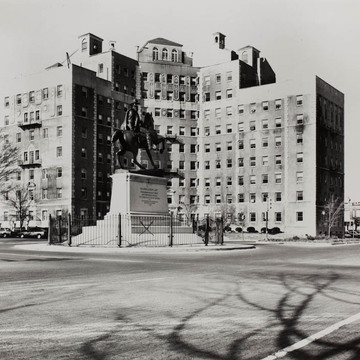Stuart Circle is named for the General J. E. B. Stuart Monument (1907, Frederick Moynihan, sculptor), which was removed on July 7, 2020 during the summer of protests whose calls for racial justice included dismantling monuments of white supremacy in public spaces. Depicting Stuart as a dashing cavalryman, it was unveiled at the largest Confederate reunion ever held, seventeen years after the dedication of the Lee Monument. Frederick Moynihan, a New York sculptor who had worked locally as a studio assistant to Richmond sculptor Edward Virginius Valentine, won the commission. The sculpture's resemblance to John Henry Foley's statue of Sir James Outram in Kolkata in India, along with the awkward stance of the prancing horse, created quite a stir at the time.
Around Stuart Circle are the Stuart Circle Hospital (1913–1914, Charles M. Robinson; later additions; 413 North Lombardy Street) and two towered Gothic Revival churches, St. John's United Church of Christ (1921–1928, Carl Lindner; 503 North Lombardy Street) and First English Evangelical Lutheran Church (1911, Charles M. Robinson; 1603 Monument Avenue), which balance each other across the circle. A third church, Grace Covenant Presbyterian Church (1922, John Kevan Peebles; 1627 Monument Avenue) is on the south side of the first block of Monument Avenue. Last but not least is the massive Stuart Court Apartments (1924, William Lawrence Bottomley; 1600 Monument Avenue), on the northwest corner of Lombardy Street, by a New York architect who became one of the most popular among wealthy Richmond patrons in the period 1918–1940. Although better known for his Colonial Revival and Georgian Revival designs, Bottomley had a facility with other styles, as demonstrated by Stuart Court, which is Mediterranean Revival. The roofline is ornamented by urns and fanciful structures, though the original cornice deteriorated and had to be removed.

